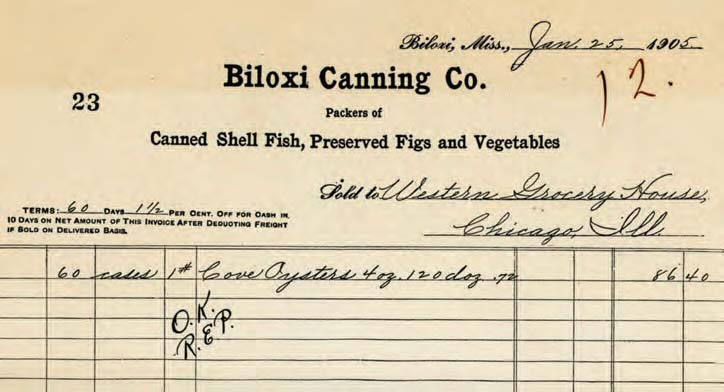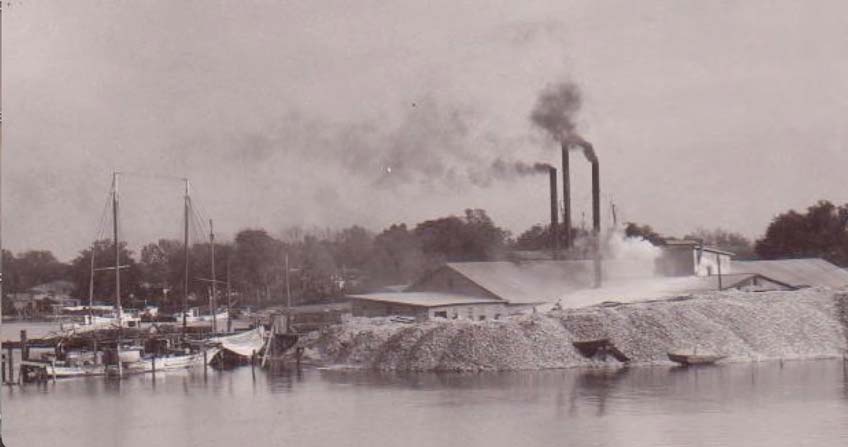Shrimp, Oysters, Figs and More: Biloxi’s Early Canneries
Posted by Paige Gutierrez on May 31st 2024
IMAGE: Pat Byrd Collection.
This article was originally written by Paige Gutierrez with the title "Oysters, Figs, and More: Biloxi’s Early Canneries" for BNews Monthly, the monthly newsletter of the City of Biloxi. All images courtesy of the Local History and Genealogy Department / Biloxi Public Library / Harrison County Library System.
Factory Town
In the 1880s, big industry came to small town Biloxi. Modern food-canning factories began to line the shore on Back Bay and on Point Cadet across from Deer Island. In 1902, The Daily Herald editors declared that “the canning industries of Biloxi” were “the most important factor in the upbuilding of south Mississippi.” Furthermore, the editors said that the “old dreamy Biloxi” that existed before canneries had grown into the “present thrifty, modern, steadily advancing Biloxi’” of the early twentieth century.
 These factories worked year-round, canning oysters, shrimp, pickled shrimp, mullet, mackerel, whole crabs, okra, tomatoes, string beans, sweet potatoes, figs, pears, peaches, and more, for national and international markets. Biloxi’s population multiplied, with newcomers from near and far arriving to work in the sprawling wooden canneries or on their fleets of working schooners. Biloxi had become a manufacturing town, like no other in Mississippi.
These factories worked year-round, canning oysters, shrimp, pickled shrimp, mullet, mackerel, whole crabs, okra, tomatoes, string beans, sweet potatoes, figs, pears, peaches, and more, for national and international markets. Biloxi’s population multiplied, with newcomers from near and far arriving to work in the sprawling wooden canneries or on their fleets of working schooners. Biloxi had become a manufacturing town, like no other in Mississippi.
IMAGE: Biloxi Canning Company invoice for a customer in Chicago, 1905. Some of their “best customers” were in London, England (Dyer 1895). Image: LHG Image Collection/Harrison County Library System.
Shrimp, Oysters and Other Seafood
The Daily Herald reported in 1902 that “the excellence of the Biloxi oyster is of world-wide fame for its flavor and size, and the demand for the gulf coast bivalve is rapidly increasing in every section of the country, both in this country and in Europe.”
At the Southern Industrial Convention in New Orleans in 1900, guest speaker W. H. Hardy stated his opinion:

“The Mississippi Sound is literally alive with fish, shrimp, and crabs, to say nothing of the oyster reefs… The Biloxi oyster is rapidly becoming as famous as the Chesapeake, and in time will equal, if it does not outstrip it in popular favor. There cannot be a more inviting field for profitable investment than in catching oysters, fish, shrimp, etc., along the Mississippi Sound for the extensive markets now accessible by reason of the improved railroad facilities for transporting them.”
One of Biloxi’s factories, Lopez & Dukate, was in 1902 the “largest individual packers of oysters, shrimp, and figs in the United States.”
IMAGE: Piles of oyster shells accumulated near the canning factories. Photo from the Joe Scholtes Collection.
Biloxi’s Famous Figs
People in D’Iberville knew it was fig-canning time in Biloxi when summer breezes carried the sweet aroma from the factories’ big open fig kettles north across the bay. Those simmering figs were grown locally by residents and nearby small farmers.
Biloxi’s soil and climate were well suited for fig trees, and in 1909 there was “hardly a family in Biloxi but what has a number of fig trees around the premises.” These trees usually bore heavy annual crops, and the canning factories bought all the figs available. Local merchants enjoyed increased sales during fig season: fig trees put money in peoples’ pockets.
Biloxi figs were known for their sweetness and high quality. They were served in the fine dining cars of passenger trains, seven figs to a can, labeled with the words “Biloxi Canning Company.” Biloxi exported more preserved figs than any city outside of California. The factories canned many fruits and vegetables, but figs were the star.
Visit our Shop page to order wild-caught Gulf shrimp to be shipped to anywhere in the country today!

